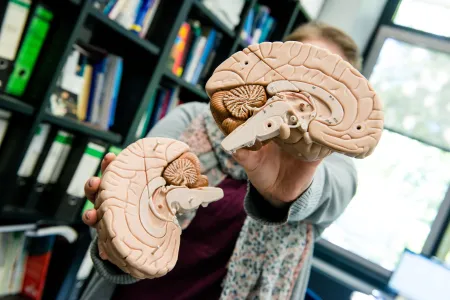Philosophy
How consciousness in animals could be researched
Animal consciousness should not be thought of as a light switch, which can be on or off, Bochum philosophers say. They advocate a different approach.
There are reasons to assume that not only humans but also some non-human species of animal have conscious perception. Which species have consciousness and how the subjective experience of various species could differ is being investigated by Professor Albert Newen and PhD student Leonard Dung from the Institute for Philosophy II at Ruhr University Bochum. To do this, they characterise consciousness with ten different dimensions and work out which behaviours indicate the presence of each of these consciousness dimensions. They describe their approach in the academic journal “Cognition”, published online on 21 February 2023.
Consciousness is not like a light switch
There is a debate within research as to which animals have consciousness. There are also various views as to how consciousness can be expressed. “According to one view, consciousness is like a light switch, which is either on or off: a species either has consciousness or it does not,” explains Albert Newen. A more refined idea is that consciousness can be thought of as a dimmer switch: it can exist in varying degrees.
Albert Newen and Leonard Dung do not agree with either of these theories. According to them, ten dimensions, or aspects, of consciousness can be distinguished, which cannot necessarily be placed in a ranking. These include, for example, a rich emotional inner life, self-awareness and or conscious perception. “It is not necessarily worthwhile to ask whether a mouse has more consciousness than an octopus,” clarifies Albert Newen. “You may get a different answer, depending on the aspect of consciousness that you are looking at.”
The researchers from Bochum suggest distinguishing between strong and weak indicators of consciousness and allocating each of these to certain aspects of consciousness. “We hope to ultimately make it possible to measure how the subjective experience of various species differs between species and compared to humans,” summarises Leonard Dung.
Strong and weak indicators of consciousness
According to the authors, the simple processing of sensory stimuli is not an indicator of consciousness. Studies of humans with brain damage show that two pathways in the brain have to interact for conscious perception, one of which processes information about the spatial position of objects and the other is responsible for the conscious classification of objects. If one of these pathways is damaged, people can correctly interact with objects – for example, inserting a letter into a letterbox – but without perceiving the letterbox as such. “As a result, the mere reception of and reaction to sensory stimuli, which we find in all living organisms, is not a noteworthy indicator of consciousness,” says Leonard Dung.
However, more complex forms of perception also occur in the animal kingdom. For example, monkeys, parrots and dogs are able to identify or categorise perceived objects as individual things. A grey parrot called Alex was able to simultaneously categorise an object as red, round and metallic. Border Collies can learn the names of up to 1,000 objects and identify and fetch certain objects. Newen and Dung describe these abilities of conscious perception as a weak indicator of consciousness.
A strong indicator of conscious perception can, however, be provided by an experiment in which a person puts on a pair of computer glasses and is shown a house in the left eye and a face in the right eye. They do not see a mixture, but instead only see the house for a while, then the face, then back to the house and so on. Analogous experiments now also exist for animals, enabling what they are consciously perceiving to be tested.
Episodic memory is a strong indicator
The authors also see episodic memory, i.e. memories of previous life events, their time and their place, as a strong indicator of consciousness. It is well documented in rats and some species of bird.
Newen and Dung argue that consciousness is closely linked to complex memory and learning abilities and with perception. In order to understand consciousness, it would be helpful if behavioural observations could be combined with neuroscientific data, which is already possible in individual cases. “However, as we do not know enough about the brain basis of conscious experience, even in humans, and we are aiming to compare widely differing species with a very different brain organisation, a behavioural comparison in ten dimensions is the best approach that we have for the time being,” concludes Albert Newen.


